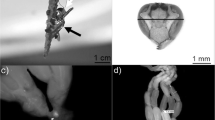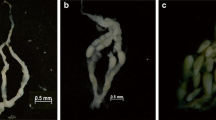Abstract.
Workers in de-queened colonies of the neotropical ant, Pachycondyla cf. inversa, form linear or near-linear dominance hierarchies by violent antennation and biting. In these rank orders, social status and ovarian activity are on average highly correlated. Whereas the presence of a fertile queen appears to be sufficient to prevent workers from laying eggs, fertile workers do not completely control reproduction by their nestmates, suggesting that workers are able to differentiate between an egg-laying queen and an egg-laying worker. Here we show that the composition of cuticular hydrocarbons of egg-laying workers is quantitatively and qualitatively different from that of non-laying workers and resembles the hydrocarbon blend of the queen but does not completely match it. Furthermore, using discriminant analysis, it was possible to distinguish workers with four different classes of ovarian development based only on their cuticular hydrocarbon profiles. Fertility-associated changes in cuticular hydrocarbons may play an important role in the behavioural regulation of reproduction in this ant.
Similar content being viewed by others
Author information
Authors and Affiliations
Additional information
Electronic Publication
Rights and permissions
About this article
Cite this article
Heinze, J., Stengl, B. & Sledge, M.F. Worker rank, reproductive status and cuticular hydrocarbon signature in the ant, Pachycondyla cf. inversa . Behav Ecol Sociobiol 52, 59–65 (2002). https://doi.org/10.1007/s00265-002-0491-1
Received:
Revised:
Accepted:
Issue Date:
DOI: https://doi.org/10.1007/s00265-002-0491-1




